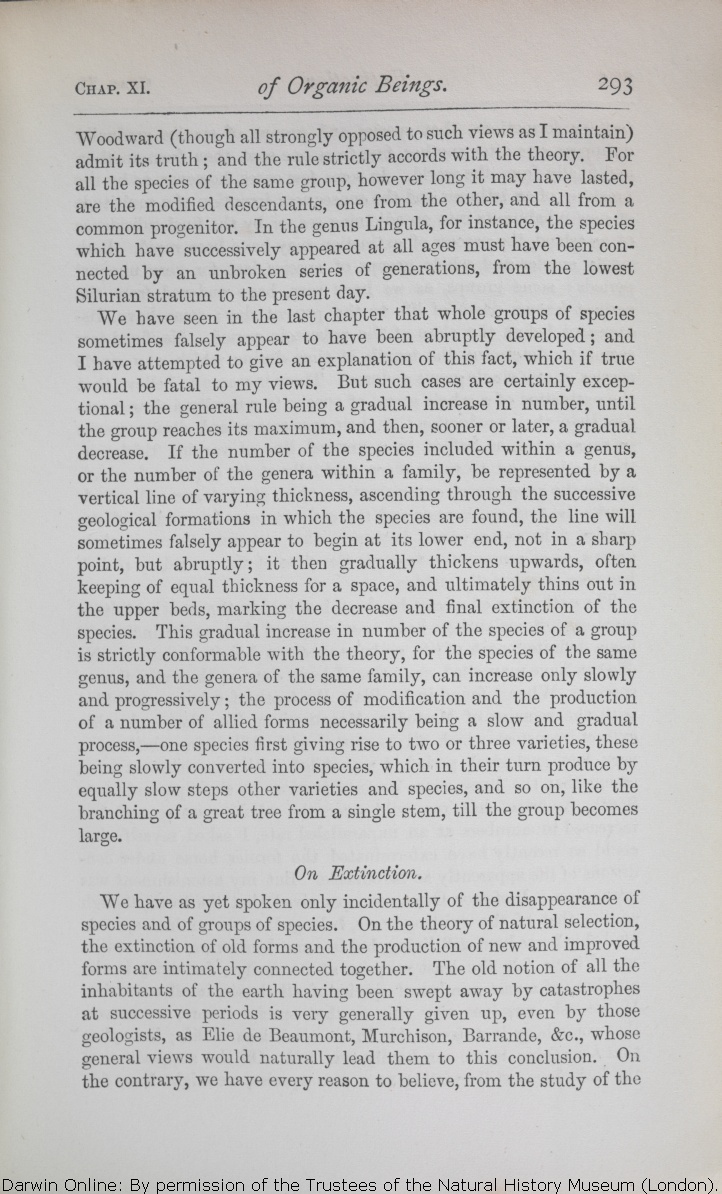Woodward (though all strongly opposed to such views as I maintain) admit its truth; and the rule strictly accords with
the | the 1869 1872 | | my 1859 1860 1861 1866 |
| 1 blocks not present in 1869 1872; present in 1859 1860 1861 1866 | | For as all the species of the same group have descended from some one species, it is clear that
as long as any species of the group have appeared in the long succession of ages,
so long must its
members have continuously
existed, in order to have
generated
either new
and modified
or the same
old and unmodified forms.
|
| descendants, 1872 | | descendants 1869 |
| one from the 1872 |
| of each 1869 |
| all from a 1872 |
| of some 1869 |
| In 1869 1872 | | Species of 1859 1860 1861 1866 |
| the species which have successively appeared at all ages must have been connected 1869 1872 |
| must have continuously existed 1859 1860 1861 1866 |
| by 1859 1860 1861 1869 1872 | | in 1866 |
| series 1869 1872 | | succession 1859 1860 1861 1866 |
|
|
We have seen in the last chapter that
whole groups of species | whole groups of species 1872 |
| the species of a group 1859 1860 1861 |
| many species of a group 1866 1869 |
| been abruptly developed; 1872 |
| come in abruptly; 1859 1860 |
| come in abruptly 1861 1866 1869 |
| and 1859 1860 1872 |
| in a body; and 1861 1866 1869 |
| be 1869 1872 | | have been 1859 1860 1861 1866 |
| until 1869 1872 | | till 1859 1860 1861 1866 |
| a 1869 1872 | | it 1859 1860 1861 1866 |
| gradual 1869 1872 | | gradually 1859 1860 1861 1866 |
| decrease. 1869 1872 | | decreases. 1859 1860 1861 1866 |
| included within 1869 1872 | | of 1859 1860 1861 1866 |
| within 1869 1872 | | of 1859 1860 1861 1866 |
| ascending through 1861 1866 1869 1872 | | crossing 1859 1860 |
| often 1861 1866 1869 1872 | | sometimes 1859 1860 |
| of equal thickness for a space, 1872 |
| for a space of equal thickness, 1859 1860 1861 1866 1869 |
| number 1859 1860 1861 1869 1872 | | the number 1866 |
| the 1869 1872 | | my 1859 1860 1861 1866 |
| theory, 1866 1869 1872 | | theory; 1859 1860 1861 |
| for 1866 1869 1872 | | as 1859 1860 1861 |
| ..... 1866 1869 1872 | | for 1859 1860 1861 |
| necessarily being a 1866 1869 1872 |
| must be 1859 1860 1861 |
| gradual process,— 1866 1869 1872 | | gradual,— 1859 1860 1861 |
| first giving rise 1866 1869 1872 |
| giving rise first 1859 1860 1861 |
| varieties 1866 1869 1872 | | species, 1859 1860 1861 |
| species, and so 1866 1869 1872 |
| so 1859 1860 1861 |
|
On
|
On
1866 1869 1872 | |
On
1859 1860 1861 |
|
Extinction
. 1869 1872 | |
Extinction
.—
1859 | |
Extinction.
—
1860 1861 | |
Extinction. 1866 |
|
We have as yet spoken only incidentally of the disappearance of species and of groups of species. On the theory of natural
selection, | selection, 1872 | | selection 1859 1860 1861 1866 1869 |
| by catastrophes at successive periods 1866 1869 1872 |
| at successive periods by catastrophes, 1859 1860 1861 |
|









